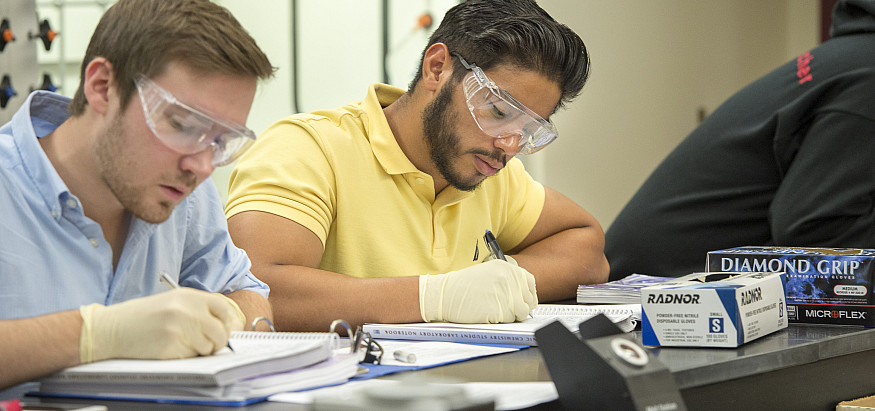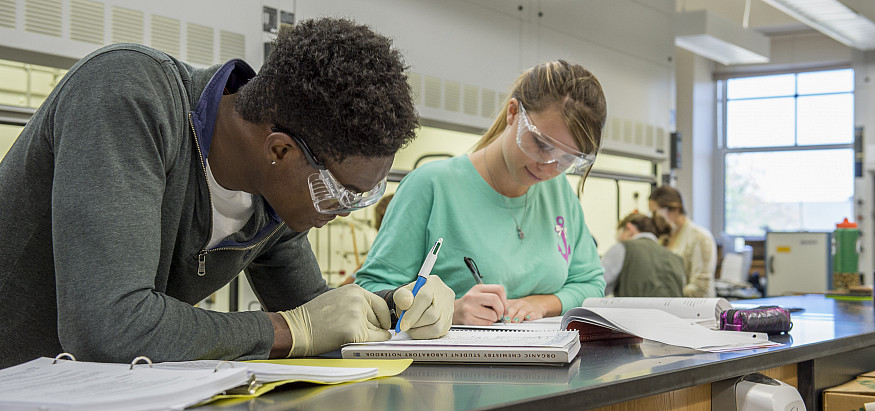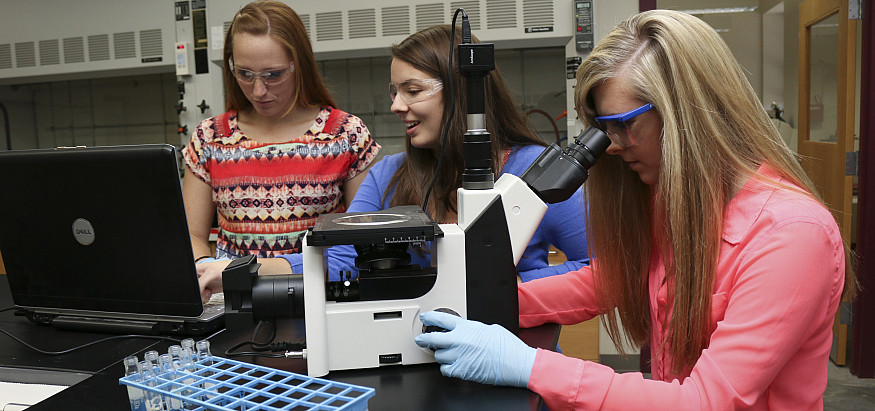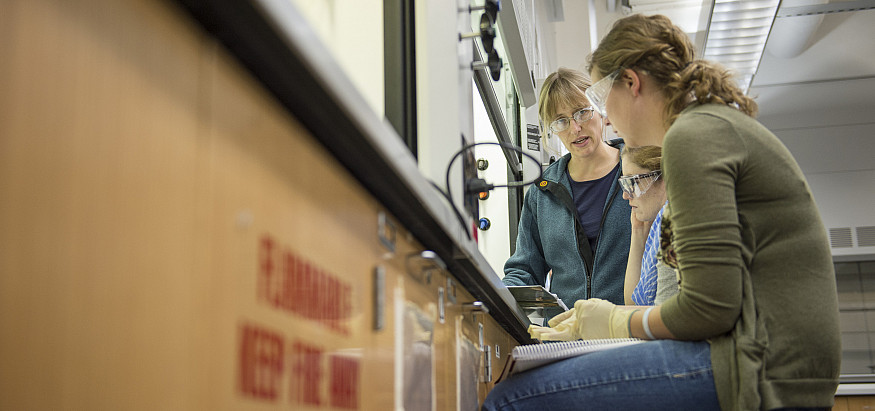Chemistry Department
- Accounting
- African-American Studies
- Animal Science
- Appalachian Studies
- Applied Data Analysis
- Art
- Biology
- Business Administration
- Chemistry
- Civic Innovation
- Clinical Mental Health Counseling and Addiction Counseling
- Creative Communication
- Economics
- Education
- Engineering Science
- English
- Environmental Studies
- Equine Assisted Therapy
- Equine Studies
- Exercise Science
- Food Studies
- Geography
- Health & Human Performance
- History
- International Studies
- Justice & the Legal System
- Management
- Mathematics
- Media and Communication
- Military Science
- Music
- Nursing
- Occupational Therapy
- Outdoor Studies
- Peace & Social Justice Studies
- Philosophy
- Philosophy, Political Science and Economics
- Physical Therapy
- Physician Assistant Studies
- Physics
- Politics, Law, and International Relations
- Pre-Engineering
- Pre-Health
- Pre-Law
- Pre-Veterinary
- Psychology
- Religion
- Sociology
- Sport Management
- Theatre
- Women & Gender Studies
- World Languages
At Emory & Henry, our student’s success is our first priority. ~99% of our majors over the last decade have either entered graduate school, professional school, or the workforce within a year of graduation. For a detailed analysis of our graduate outcomes click here. The chemistry faculty have been recognized with four statewide awards for teaching excellence as well as several college wide awards. Full time faculty within the department teach all classes and labs and use multiple instructional methods in our courses to maximize student learning and best prepare you for success after E&H.
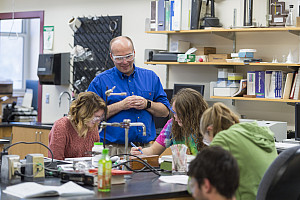
For more information, contact James Duchamp.
Degrees
-
Bachelor of Arts, Chemistry- Applied Health Sciences
To prepare students for admission to pharmacy programs and careers in pharmacy.
-
Bachelor of Science, Chemistry
To prepare students for graduate study related to chemistry or the health/medical professions and also for employment in various areas of chemistry.
-
Minor, Chemistry
A student may minor in chemistry by completing Chemistry 111, 111L, 112, 112L, and four courses chosen from Chemistry 211, 212, 211, 212, 221, 230, 240, 312, 313, 330, 430X, and 433.
-
Bachelor of Arts, Chemistry- Teacher Preparation
To enable students to meet Virginia requirements for licensure to teach chemistry.
-
Bachelor of Science, Chemistry- Teacher Preparation
To enable students to meet Virginia requirements for licensure to teach chemistry.
-
Bachelor of Arts, Chemistry
To prepare students for work as chemists in industry or as teachers.
Student Research
- <h4 class="lw_blurbs_title">Biocatalytic Cyclopropanation of Fatty Acid Chains</h4><div class="lw_blurbs_body"><p> Chemistry and Spanish double major Xavier Marshall (E&H ’18) is attempting to prepare cyclopropanated derivatives of fatty acid chains, using the enzyme cyclopropane fatty acid synthase (CFA synthase) as a catalyst. These products would be useful synthetic building blocks in preparing cyclopropanated long-chain ionic liquids, which have shown promise as stationary phases for gas chromatography. CFA synthase, whose natural substrate is <em>cis</em>-unsaturated phospholipids in the membranes of <em>E. coli</em>, might be able to accomplish the cyclopropanation of <em>cis</em>-fatty acid derivatives more efficiently than can be accomplished <em>via</em> conventional organic synthesis. Xavier is preparing a variety of derivatives and formulations of oleic acid to try with CFA synthase.</p></div>
- <h4 class="lw_blurbs_title">Effect of atmospheric carbon dioxide on corrosion of porous silica</h4><div class="lw_blurbs_body"><p> Chemistry major B.G. Loper (E&H ’18) is studying the effects of atmospheric carbon dioxide on the corrosion behavior of porous silica glasses in unbuffered solutions. B.G. is fabricating an environmental chamber that can be purged of carbon dioxide so that the effect can be easily measured. The results are applicable to a range of industrial practices that utilize unbuffered systems to clean and/or treat materials.</p></div>
- <h4 class="lw_blurbs_title">Microfluidic Flow Reactor for Chemical Detection</h4><div class="lw_blurbs_body"><p><picture class="lw_image lw_image6319 lw_align_left"><source type="image/webp" srcset="/live/image/gid/11/width/400/height/626/6319_IMG_0964.rev.1556157415.webp 1x" data-origin="responsive"/><source type="image/jpeg" srcset="/live/image/gid/11/width/400/height/626/6319_IMG_0964.rev.1556157415.jpg 1x" data-origin="responsive"/><img width="400" height="626" alt="Rebekah Watters" src="/live/image/gid/11/width/400/height/626/6319_IMG_0964.rev.1556157415.jpg" data-max-w="537" data-max-h="840" loading="lazy" data-optimized="true"/></picture>Senior chemistry, math, and physics triple major Rebekah Watters (E&H ’19) is designing, fabricating, and testing a system to detect triclosan, a common antibacterial added to consumer products. Rebekah’s project combines chemistry and engineering by taking a process that normally requires multiple steps and large volumes (think about baking a cake with the volumes and number of steps) and reduces it to a system that fits in the palm of your hand and can be run in a single step.</p></div>
- <h4 class="lw_blurbs_title">Microplastic Contamination in Virginia’s Holston River</h4><div class="lw_blurbs_body"><p><picture class="lw_image lw_image6314 lw_align_left"><source type="image/webp" srcset="/live/image/gid/11/width/389/height/520/6314_Rafe.rev.1556030202.webp 1x" data-origin="responsive"/><source type="image/png" srcset="/live/image/gid/11/width/389/height/520/6314_Rafe.rev.1556030202.png 1x" data-origin="responsive"/><img width="389" height="520" alt="Rafe Hagee" src="/live/image/gid/11/width/389/height/520/6314_Rafe.rev.1556030202.png" data-max-w="389" data-max-h="520" loading="lazy" data-optimized="true"/></picture>Rafe Hagee (E&H ’19) completed an Honor’s thesis studying microplastic contamination in Virginia’s Holston River. Rafe’s study focused on determining if microplastics were contaminating the three forks of the Holston River in Southwest Virginia. In order to assess contamination, he used plankton nets to collect microplastic particles. The nets were then processed in the lab to isolate the plastic particles for analysis. Additional analysis was done using Fourier transform Infrared Spectroscopy, and the results were compared to a reference film to ensure identification of the plastic particles.</p></div>
- <h4 class="lw_blurbs_title">Exploring the phytoremediation potential of kale plants</h4><div class="lw_blurbs_body"><p><picture class="lw_image lw_image3190 lw_align_left"><source type="image/webp" srcset="/live/image/gid/11/width/250/height/333/3190_IMG_4176.rev.1518454132.webp 1x" data-origin="responsive"/><source type="image/jpeg" srcset="/live/image/gid/11/width/250/height/333/3190_IMG_4176.rev.1518454132.jpg 1x" data-origin="responsive"/><img width="250" height="333" alt="Holly Roth research" src="/live/image/gid/11/width/250/height/333/3190_IMG_4176.rev.1518454132.jpg" data-max-w="480" data-max-h="640" loading="lazy" data-optimized="true"/></picture>Holly Roth’s (E&H ’18) honors thesis research project focuses on measuring the phytoremediation potential of kale plants (<em>Brassica oleracea</em>). Members of the <em>Brassica</em>(kale, cabbage, broccoli…) family function as “hyperaccumulators” and can extract and store high concentrations of heavy metals. Holly has developed an experimental design for testing the uptake of lead and copper from contaminated soils by kale plants under several different treatment conditions including pH adjustment and EDTA applications. Tissue samples from 50 plants grown under varying conditions will be analyzed for lead and copper using atomic absorption spectrophotometry, and the effects of pH and EDTA will be assessed. </p></div>
- <h4 class="lw_blurbs_title">Synthesis of Long Chain Internal Alkyn-1-ol Synthons for Imidazolium-Based Ionic Liquids</h4><div class="lw_blurbs_body"><p><picture class="lw_image lw_image5758 lw_align_left"><source type="image/webp" srcset="/live/image/scale/2x/gid/11/width/300/height/400/5758_IMG_0372.rev.1544799691.webp 2x, /live/image/scale/3x/gid/11/width/300/height/400/5758_IMG_0372.rev.1544799691.webp 3x" data-origin="responsive"/><source type="image/jpeg" srcset="/live/image/scale/2x/gid/11/width/300/height/400/5758_IMG_0372.rev.1544799691.JPG 2x, /live/image/scale/3x/gid/11/width/300/height/400/5758_IMG_0372.rev.1544799691.JPG 3x" data-origin="responsive"/><img width="300" height="400" alt="Nathan in lab" src="/live/image/gid/11/width/300/height/400/5758_IMG_0372.rev.1544799691.JPG" srcset="/live/image/scale/2x/gid/11/width/300/height/400/5758_IMG_0372.rev.1544799691.JPG 2x, /live/image/scale/3x/gid/11/width/300/height/400/5758_IMG_0372.rev.1544799691.JPG 3x" data-max-w="1512" data-max-h="2016" loading="lazy" data-optimized="true"/></picture>Nathan Neisius (E&H ’19) completed an Honor’s thesis synthesizing ionic liquids. Nathan’s project was to synthesize long chain internal alkyne imidazolium-based ionic liquids to determine how internal alkyne units of unsaturation will affect the properties of the ionic liquids. Nuclear magnetic resonance spectroscopy, thin-layer chromatography, and infrared spectroscopy were utilized to evaluate the efficiency of syntheses. As of now, long chain internal alkyne imidazolium-based ionic liquids have yet to synthesized from this method. Conditions needed for the reactions and work-up have been partially optimized for future research students to finish synthesizing the desired ionic liquids.</p></div>
Meet Our Alumni
- <span class="lw_item_thumb"><a href="/live/profiles/2379-bg-loper"><picture class="lw_image"><source type="image/webp" srcset="/live/image/gid/11/width/345/height/225/crop/1/src_region/0,0,127,127/5299_EASTMAN_u777980_LThumb.rev.1540913767.webp 1x" data-origin="responsive"/><source type="image/jpeg" srcset="/live/image/gid/11/width/345/height/225/crop/1/src_region/0,0,127,127/5299_EASTMAN_u777980_LThumb.rev.1540913767.jpg 1x" data-origin="responsive"/><img src="/live/image/gid/11/width/345/height/225/crop/1/src_region/0,0,127,127/5299_EASTMAN_u777980_LThumb.rev.1540913767.jpg" alt="BG Loper" width="345" height="225" data-max-w="127" data-max-h="127" loading="lazy" data-optimized="true"/></picture></a></span><div class="lw_widget_text"><h4 class="lw_profiles_headline"><a href="/live/profiles/2379-bg-loper"><p> Hitting the ground running …</p></a></h4><div class="lw_profiles_description"><ul><li>You just graduated (’18) and have landed your first job. Can you tell us a little about it? </li></ul><div dir="auto"> I’m a little overwhelmed in a good way. I will be a lab technician in a major chemical company. It’s a very good entry-level job in my field of study which is something not very many recent graduates can say. I feel extremely blessed and honored.</div><div dir="auto"></div><div dir="auto"></div><ul><li dir="auto">What do you think was the most valuable aspect of your E&H education? </li></ul><div dir="auto"></div><div dir="auto"> I think the most valuable aspect of my education at E&H is kind of two parts to the same whole. I appreciate the relationships that students are able to form with faculty and my ability to have true mentors in my professors/advisors that shaped my life immeasurably. The other part of it is the outside of the box thinking that is encouraged, but that can only happen from a good relationship with an advisor/professor, so it’s still part of the same reason.</div><div dir="auto"></div><div dir="auto"></div><ul><li dir="auto">What advice would you give to current students? </li></ul><div dir="auto"></div><div dir="auto"> Make use of the incredible resources that are available to you. Visit your professors as often as you’re able and study/do research under their direction as well.</div></div><a href="/live/profiles/2379-bg-loper" class="link-with-arrow gold">Keep reading</a></div>
- <span class="lw_item_thumb"><a href="/live/profiles/2331-gavin-irvine"><picture class="lw_image"><source type="image/webp" srcset="/live/image/scale/2x/gid/11/width/345/height/225/crop/1/src_region/0,0,3200,2400/4717_IMG_20171011_114448.rev.1538018879.webp 2x, /live/image/scale/3x/gid/11/width/345/height/225/crop/1/src_region/0,0,3200,2400/4717_IMG_20171011_114448.rev.1538018879.webp 3x" data-origin="responsive"/><source type="image/jpeg" srcset="/live/image/scale/2x/gid/11/width/345/height/225/crop/1/src_region/0,0,3200,2400/4717_IMG_20171011_114448.rev.1538018879.jpg 2x, /live/image/scale/3x/gid/11/width/345/height/225/crop/1/src_region/0,0,3200,2400/4717_IMG_20171011_114448.rev.1538018879.jpg 3x" data-origin="responsive"/><img src="/live/image/gid/11/width/345/height/225/crop/1/src_region/0,0,3200,2400/4717_IMG_20171011_114448.rev.1538018879.jpg" alt="Gavin Irvine" width="345" height="225" srcset="/live/image/scale/2x/gid/11/width/345/height/225/crop/1/src_region/0,0,3200,2400/4717_IMG_20171011_114448.rev.1538018879.jpg 2x, /live/image/scale/3x/gid/11/width/345/height/225/crop/1/src_region/0,0,3200,2400/4717_IMG_20171011_114448.rev.1538018879.jpg 3x" data-max-w="3200" data-max-h="2400" loading="lazy" data-optimized="true"/></picture></a></span><div class="lw_widget_text"><h4 class="lw_profiles_headline"><a href="/live/profiles/2331-gavin-irvine"><p> Gavin Irvine, Ph.D. candidate in Chemistry</p></a></h4><div class="lw_profiles_description"><div><p> Tell us a little about what you’ve been doing since graduating from E&H. </p><p> It has been a bit of circuitous route for me. After spending two years at the University of Notre Dame, graduating with a Master’s, I headed off to China for two years to teach. Using the proceeds of those jobs, I took a year off to travel and write a book of poetry for a year and a half, before applying and be accepted to the PhD program in Chemistry at the University of St Andrews in Scotland. </p><p> </p><p> What are the applications of your work? </p><p> My research deals with solid state electrolytes. In essence, the goal is replace liquids in batteries with solids in order to stabilize their performance and increase longevity. As you can imagine, to get the same transport properties (the movement of ions through the material) in a solid as a liquid is quite challenging. </p><p> </p><p> What do you think was the most valuable aspect of your E&H education? </p><p> When I look back on E&H I see great professors in so many classes I took. I remember taking History of the Caribbean with Dr. Little, taking what was then called Great Books with Dr. Chamberlain, Western Tradition with Dr. Vejnar, Ethics with Dr. Grossman just to name a few. The liberal arts aspect of E&H can be seen in my diverse set of interests to the present day. Alas, lets not forget about the Chemistry and Mathematics professors: Dr. Lane, Dr. Duchamp, Dr. Hainsworth, Dr. Li, Dr. Iskra, and Dr. Winger. These professors were not only great teachers, but greater mentors whom helped me get involved in research, and engaged me in deep philosophical rambling during their spare time. </p><p> </p><p> To find out more about Gavin’s work, visit his group page <a href="http://jtsigroup.wp.st-andrews.ac.uk/gavin-irvine/" target="_blank" rel="noopener noreferrer">here</a>.<img class="ajT" src="https://ssl.gstatic.com/ui/v1/icons/mail/images/cleardot.gif" alt="" loading="lazy"/></p></div><div class="yj6qo ajU"></div></div><a href="/live/profiles/2331-gavin-irvine" class="link-with-arrow gold">Keep reading</a></div>
- <span class="lw_item_thumb"><a href="/live/profiles/715-mary-grace-hankins"><picture class="lw_image"><source type="image/webp" srcset="/live/image/gid/2/width/345/height/225/crop/1/src_region/0,0,300,191/365_MaryGraceHankins15.rev.1500390853.webp 1x" data-origin="responsive"/><source type="image/png" srcset="/live/image/gid/2/width/345/height/225/crop/1/src_region/0,0,300,191/365_MaryGraceHankins15.rev.1500390853.png 1x" data-origin="responsive"/><img src="/live/image/gid/2/width/345/height/225/crop/1/src_region/0,0,300,191/365_MaryGraceHankins15.rev.1500390853.png" alt="" width="345" height="225" data-max-w="300" data-max-h="191" loading="lazy" data-optimized="true"/></picture></a></span><div class="lw_widget_text"><h4 class="lw_profiles_headline"><a href="/live/profiles/715-mary-grace-hankins"><p> Fourth Generation E&H Student </p></a></h4><div class="lw_profiles_description"><h3><strong>As a fourth generation Emory & Henry student, Mary Grace has served the college community as a leader and a student.</strong></h3><p> Mary Grace was a fourth generation Emory & Henry student from Boones Mill, VA. who majored in Chemistry. She is now attending the UNC Eshelman School of Pharmacy in Chapel Hill, NC to pursue a doctorate of pharmacy. Her Senior Honors Thesis involved analyzing water samples from sites along the three forks of the Holston River and testing them for the presence of triclosan. The purpose of the research was to find whether or not triclosan is present in surface waters in the Southwest Virginia area. </p><p> In addition to being in the Honors Program, Mary Grace was the Vice President of Student Government, President of the Emory Activities Board, President of Delta Omicron Pi social sorority, and a member of Cardinal Key Honor Society. She was also extremely involved with the Orientation Program from serving as a volunteer orientation leader after her freshman year to eventually serving as the Student Chair of Orientation Programs. Mary Grace said, “I had so many amazing experiences in my time [at Emory, but if I were] to pick just one favorite memory of Emory & Henry, it would be the moment when Fall 2014 Orientation finally got started and it was my turn to officially welcome the Class of 2018 to campus.” </p><p> As part of the Honors Program experience, we encourage our scholars to partake in various travel opportunities, whether it is going to <a href="https://honors.ehc.edu/new-york-city">New York City</a> with their cohort or <a href="https://honors.ehc.edu/study-abroad">study abroad</a>. Mary Grace was among the first group of students who participated in the first Honors Program sponsored trip to Greece in Spring 2013. She said, “It was my first time out of the country, and I got to see so many incredible, ancient places.” Afterwards, during her junior year, she received the Emily Williams English-Speaking Union Scholarship and was able to study at the University of Cambridge for two weeks in the summer. While there, she studied the early stages of pharmaceutical<em> </em>drug discovery and the immune system. </p></div><a href="/live/profiles/715-mary-grace-hankins" class="link-with-arrow gold">Keep reading</a></div>
- <span class="lw_item_thumb"><a href="/live/profiles/2341-haleigh-conley"><picture class="lw_image"><source type="image/webp" srcset="/live/image/scale/2x/gid/11/width/345/height/225/crop/1/src_region/0,0,2133,3200/4761_Haleigh_Conley--5_1.rev.1538754955.webp 2x, /live/image/scale/3x/gid/11/width/345/height/225/crop/1/src_region/0,0,2133,3200/4761_Haleigh_Conley--5_1.rev.1538754955.webp 3x" data-origin="responsive"/><source type="image/jpeg" srcset="/live/image/scale/2x/gid/11/width/345/height/225/crop/1/src_region/0,0,2133,3200/4761_Haleigh_Conley--5_1.rev.1538754955.jpg 2x, /live/image/scale/3x/gid/11/width/345/height/225/crop/1/src_region/0,0,2133,3200/4761_Haleigh_Conley--5_1.rev.1538754955.jpg 3x" data-origin="responsive"/><img src="/live/image/gid/11/width/345/height/225/crop/1/src_region/0,0,2133,3200/4761_Haleigh_Conley--5_1.rev.1538754955.jpg" alt="Haleigh (Cole) Conley" width="345" height="225" srcset="/live/image/scale/2x/gid/11/width/345/height/225/crop/1/src_region/0,0,2133,3200/4761_Haleigh_Conley--5_1.rev.1538754955.jpg 2x, /live/image/scale/3x/gid/11/width/345/height/225/crop/1/src_region/0,0,2133,3200/4761_Haleigh_Conley--5_1.rev.1538754955.jpg 3x" data-max-w="2133" data-max-h="3200" loading="lazy" data-optimized="true"/></picture></a></span><div class="lw_widget_text"><h4 class="lw_profiles_headline"><a href="/live/profiles/2341-haleigh-conley"><p> Haleigh (Cole) Conley</p></a></h4><div class="lw_profiles_description"><div dir="auto"><div dir="auto"><p> Tell us a little about what you’ve been doing since graduating from E&H. </p><p> After graduating from E&H in 2016, I worked at the Duke Human Vaccine Institute in a HIV vaccine research lab. I recently joined a Ph.D. cohort at North Carolina State University in Comparative Biomedical Sciences. I plan on focusing on Infectious Disease Research. </p><p> </p><p> What do you think was the most valuable aspect of your E&H education? </p><p> There were many valuable aspects of my education at E&H. I believe that my professors challenged me in a way that would bring out my ultimate potential. On a more personal note, I met so many people that have had a lasting impact on me. </p><p> </p><p> What advice would you give to current students? </p><p> My advice to current students is to be open and willing to pursue the things that challenge you: take that upper level class that scares you, take on that extra research project, visit your professors often for advice. There are many opportunities to elevate your education that are outside of the typical class structure, and those opportunities are what define your undergraduate education. </p></div></div></div><a href="/live/profiles/2341-haleigh-conley" class="link-with-arrow gold">Keep reading</a></div>
- <span class="lw_item_thumb"><a href="/live/profiles/17-kyle-boden"><picture class="lw_image"><source type="image/webp" srcset="/live/image/scale/2x/gid/2/width/345/height/225/crop/1/src_region/0,0,1000,666/26_28f97829f69611f15958da5f58be5431_f42621.rev.1490711184.webp 2x" data-origin="responsive"/><source type="image/jpeg" srcset="/live/image/scale/2x/gid/2/width/345/height/225/crop/1/src_region/0,0,1000,666/26_28f97829f69611f15958da5f58be5431_f42621.rev.1490711184.jpg 2x" data-origin="responsive"/><img src="/live/image/gid/2/width/345/height/225/crop/1/src_region/0,0,1000,666/26_28f97829f69611f15958da5f58be5431_f42621.rev.1490711184.jpg" alt="" width="345" height="225" srcset="/live/image/scale/2x/gid/2/width/345/height/225/crop/1/src_region/0,0,1000,666/26_28f97829f69611f15958da5f58be5431_f42621.rev.1490711184.jpg 2x" data-max-w="1000" data-max-h="666" loading="lazy" data-optimized="true"/></picture></a></span><div class="lw_widget_text"><h4 class="lw_profiles_headline"><a href="/live/profiles/17-kyle-boden"><p> Kyle Boden ’14 Continues to Find Success in Medical School</p></a></h4><div class="lw_profiles_description"><p> Kyle Boden became keenly aware of his responsibility to serve the community while attending Emory & Henry College.</p><p> During his first year at Emory & Henry, Boden found time to drive to a local elementary school where he read to a classroom of kindergarten students before returning to campus to switch gears, strapping on a football uniform for evening practice.</p><p> His contributions on campus didn’t stop there. Honor student, skilled football player, and student leader, Boden has always been the epitome of what it takes to be admired and honored.</p><p> No doubt, his desire to serve others is what prompted the 2014 graduate to pursue a medical career. Beginning his second semester at East Tennessee State University’s Quillen College of Medicine, Boden has a particular interest in orthopedic surgery.</p><blockquote> I am the first in my family to become a physician and to choose this specialty because I believe it provides a unique opportunity to positively impact those in my community. Medicine also provides an excellent opportunity to bridge the gap between my interest in the biological sciences and my desire to help people on a daily basis.</blockquote><p> “Emory & Henry taught me that it is better to dream the biggest, wildest dreams imaginable than to live my life in fear of failure. More importantly, Emory & Henry helped me develop the leadership skills necessary to provide the best possible care to my patients.”</p><p> Boden said he was taught by many professors who left a lasting mark on him. “As a student at Emory & Henry, I valued the relationships I developed with my professors the most. It meant a great deal knowing my professors valued my growth as a person just as much, if not more than, my growth as a student.”</p><p> Boden’s accomplishments while a student at E&H did not go without recognition.</p><p> Boden, who played quarter back at the College, was awarded last May the Walter Byers Postgraduate Scholarship, one of the top scholar-athlete awards from the National Collegiate Athletic Association (NCAA). The award is given annually to one male and one female who are selected from among the more than 1,100 member institutions throughout all three NCAA divisions.</p><p> “It was an honor to receive the Walter Byers Postgraduate Scholarship and to represent Emory & Henry on a national level,” Boden said. “I had the opportunity to go to the awards ceremony with my family in New Orleans last month and tell members of the NCAA from throughout the country how Emory & Henry shaped me into the person I am today.”</p><p> The scholarship provides $48,000 of financial assistance toward post graduate education throughout the next two years.</p><p> Boden also was Emory & Henry’s first Rhodes Scholar finalist in 109 years. The Rhodes Scholarships are the oldest and most celebrated international fellowship awards. The scholarship provides 32 recipients annually with an opportunity to study at Oxford University in England. Rhodes Scholars are chosen not only for their outstanding academic achievements, but for their character, leadership, and commitment to others.</p><p> “I don’t get caught up in individual awards and accomplishments because my success at Emory & Henry was due to so many people who invested in me and pushed me to become the person I am today,” he said.</p><p> “I hope people remember me as someone who lives each day to the fullest and treats his peers with respect and compassion.”</p></div><a href="/live/profiles/17-kyle-boden" class="link-with-arrow gold">Keep reading</a></div>
- <span class="lw_item_thumb"><a href="/live/profiles/2941-hayden-hale"><picture class="lw_image"><source type="image/webp" srcset="/live/image/scale/2x/gid/11/width/345/height/225/crop/1/src_region/0,0,708,960/6826_69064871_10219935011629757_3126244121379864576_n.rev.1567738500.webp 2x" data-origin="responsive"/><source type="image/jpeg" srcset="/live/image/scale/2x/gid/11/width/345/height/225/crop/1/src_region/0,0,708,960/6826_69064871_10219935011629757_3126244121379864576_n.rev.1567738500.jpg 2x" data-origin="responsive"/><img src="/live/image/gid/11/width/345/height/225/crop/1/src_region/0,0,708,960/6826_69064871_10219935011629757_3126244121379864576_n.rev.1567738500.jpg" alt="Hayden Hale" width="345" height="225" srcset="/live/image/scale/2x/gid/11/width/345/height/225/crop/1/src_region/0,0,708,960/6826_69064871_10219935011629757_3126244121379864576_n.rev.1567738500.jpg 2x" data-max-w="708" data-max-h="960" loading="lazy" data-optimized="true"/></picture></a></span><div class="lw_widget_text"><h4 class="lw_profiles_headline"><a href="/live/profiles/2941-hayden-hale"><p> Love of learning leads to veterinary school</p></a></h4><div class="lw_profiles_description"><p> Hayden Hale was always a curious sort. Sometimes he was curious about why he was in a class, but most of the time he was just curious about what was going on. Now, in his first year at the Virginia-Maryland Collage of Veterinary Medicine, he is putting his love of learning and passion for animals to work as he studies small animal medicine. Reflecting on the past and future Hayden says, “Five years ago, I thought chemistry was annoying, and I didn’t care what things did below the molecular level. The E&H professors made chemistry fun and interesting and showed me the cool things it can actually do and lead me towards the major. While I have chosen a more biology focused career, I have come to value my understanding of the driving force behind the biology, and I feel I will continue to value it more and more as the semesters come.” </p></div><a href="/live/profiles/2941-hayden-hale" class="link-with-arrow gold">Keep reading</a></div>
- <span class="lw_item_thumb"><a href="/live/profiles/2543-dr-clarissa-tatum"><picture class="lw_image"><source type="image/webp" srcset="/live/image/gid/68/width/345/height/225/crop/1/src_region/0,5,127,132/6005_EASTMAN_u772853_LThumb.rev.1551199284.webp 1x" data-origin="responsive"/><source type="image/jpeg" srcset="/live/image/gid/68/width/345/height/225/crop/1/src_region/0,5,127,132/6005_EASTMAN_u772853_LThumb.rev.1551199284.jpg 1x" data-origin="responsive"/><img src="/live/image/gid/68/width/345/height/225/crop/1/src_region/0,5,127,132/6005_EASTMAN_u772853_LThumb.rev.1551199284.jpg" alt="Dr. Clarissa Tatum, E&H Class of 2005." width="345" height="225" data-max-w="127" data-max-h="127" loading="lazy" data-optimized="true"/></picture></a></span><div class="lw_widget_text"><h4 class="lw_profiles_headline"><a href="/live/profiles/2543-dr-clarissa-tatum"></a></h4><div class="lw_profiles_description"><p> Clarissa Tatum was a chemistry major at Emory & Henry, and played tennis on the varsity team.</p><p> These days she is a research chemist at Eastman Chemical Company focusing on a polymeric fiber product used in a number of applications. Aside from developing and optimizing product applications, she also oversees the product’s analytical testing lab and provides technical assistance to customers.</p><p> She serves as a representative on the E&H Alumni Board of Directors and is a volunteer for an alumni event called “E&H in the City” where alumni are invited to a happy hour event in order to meet other grads in their neighborhood. In 2018, more than 600 alumni participated in this all-volunteer-led event. </p></div><a href="/live/profiles/2543-dr-clarissa-tatum" class="link-with-arrow gold">Keep reading</a></div>
- <span class="lw_item_thumb"><a href="/live/profiles/2569-ryan-hasty"><picture class="lw_image"><source type="image/webp" srcset="/live/image/scale/2x/gid/68/width/345/height/225/crop/1/src_region/0,0,960,960/6063_profile_1.rev.1552564875.webp 2x" data-origin="responsive"/><source type="image/jpeg" srcset="/live/image/scale/2x/gid/68/width/345/height/225/crop/1/src_region/0,0,960,960/6063_profile_1.rev.1552564875.jpg 2x" data-origin="responsive"/><img src="/live/image/gid/68/width/345/height/225/crop/1/src_region/0,0,960,960/6063_profile_1.rev.1552564875.jpg" alt="Ryan Hasty E&H Class of 2010" width="345" height="225" srcset="/live/image/scale/2x/gid/68/width/345/height/225/crop/1/src_region/0,0,960,960/6063_profile_1.rev.1552564875.jpg 2x" data-max-w="960" data-max-h="960" loading="lazy" data-optimized="true"/></picture></a></span><div class="lw_widget_text"><h4 class="lw_profiles_headline"><a href="/live/profiles/2569-ryan-hasty"><p> Ryan Hasty is in research and development at Makani Power, a spinoff of Google X. And while he values his science education, he especially appreciates the ethical discussions behind science that punctuated his education at Emory & Henry.</p></a></h4><div class="lw_profiles_description"><p> Ryan Hasty works at Makani Power, a wind energy R&D project that was spun off from Google’s <a href="https://www.ehc.edu/live/image/gid/68/width/650/6062_ryan_hasty.png" class="lw_preview_image"><picture class="lw_image lw_image6062 lw_align_left lw_column_width_half"><source type="image/webp" srcset="/live/image/scale/2x/gid/68/width/500/height/333/6062_ryan_hasty.rev.1552504772.webp 2x, /live/image/scale/3x/gid/68/width/500/height/333/6062_ryan_hasty.rev.1552504772.webp 3x" data-origin="responsive"/><source type="image/png" srcset="/live/image/scale/2x/gid/68/width/500/height/333/6062_ryan_hasty.rev.1552504772.png 2x, /live/image/scale/3x/gid/68/width/500/height/333/6062_ryan_hasty.rev.1552504772.png 3x" data-origin="responsive"/><img width="500" height="333" alt="A photo of Ryan Hasty's flight project at Makani Power." src="/live/image/gid/68/width/500/height/333/6062_ryan_hasty.rev.1552504772.png" srcset="/live/image/scale/2x/gid/68/width/500/height/333/6062_ryan_hasty.rev.1552504772.png 2x, /live/image/scale/3x/gid/68/width/500/height/333/6062_ryan_hasty.rev.1552504772.png 3x" data-max-w="2000" data-max-h="1333" loading="lazy" data-optimized="true"/></picture><span class="lw_image_caption lw_column_width_half lw_align_left" style="width: 500px">A photo of Ryan Hasty's flight project at Makani Power.</span></a>secretive research division known as X. “We are developing an airborne energy kite technology that integrates advances in aerospace engineering, materials science, and autonomous controls. As a prototype engineer on a small team, my objectives range from flight hardware integration to prototype design and flight testing.”<br/><br/> He says what he loves most about the work is “the amalgamation of advanced aerospace concepts with experimental clean energy. The evidence of anthropogenic climate change is clear and unequivocal. Our decisions from here forward with respect to energy production will have a significant impact on future life on earth. This project is one of many new energy technologies aimed at pushing the limits of what we know to be possible.”<br/><br/> He says research and development work is challenging by definition – the whole idea is to try something that has never been done before. But therein also lies R&D’s greatest excitement. “Exploration and creativity speak to something innate and instinctive within us as humans, and the highest expression of these instincts are the things or ideas we bring into the world.”<br/><br/> Ryan studied Chemistry and Environmental Studies at Emory & Henry. He says he is, of course, benefiting from the technical aspects he learned from his major study areas, but he especially values the opportunities Emory & Henry gave him to ask the ethical questions behind science and technological development. “It’s not enough to ask ourselves whether we <em>can</em> build something, we must seriously ask whether or not we <em>should</em>. These questions are critical to our future with the rapid progression of aerospace technologies, robotics and artificial intelligence.”<br/><br/> When he’s not creating and molding new ideas, he can be found serving as a mentor to several local high school F.I.R.S.T Robotics Teams and can be found building combat robots for ABC’s ‘Battlebots.” He is also a dedicated practitioner of Brazilian Jiu Jitsu and supports homeless rights efforts in the Bay Area.</p></div><a href="/live/profiles/2569-ryan-hasty" class="link-with-arrow gold">Keep reading</a></div>
- <span class="lw_item_thumb"><a href="/live/profiles/706-kellie-flaherty"><picture class="lw_image"><source type="image/webp" srcset="/live/image/gid/2/width/345/height/225/crop/1/src_region/0,0,100,100/356_static1.squarespace.rev.1500388033.webp 1x" data-origin="responsive"/><source type="image/jpeg" srcset="/live/image/gid/2/width/345/height/225/crop/1/src_region/0,0,100,100/356_static1.squarespace.rev.1500388033.jpg 1x" data-origin="responsive"/><img src="/live/image/gid/2/width/345/height/225/crop/1/src_region/0,0,100,100/356_static1.squarespace.rev.1500388033.jpg" alt="" width="345" height="225" data-max-w="100" data-max-h="100" loading="lazy" data-optimized="true"/></picture></a></span><div class="lw_widget_text"><h4 class="lw_profiles_headline"><a href="/live/profiles/706-kellie-flaherty"><p> Pursing a Passion for Helping Others </p></a></h4><div class="lw_profiles_description"><p> During Kellie’s time at E&H she discovered her passion for helping others through the healthcare field and desire to become a PA.</p><p> I graduated from E&H with a B.S. in Biology and minor in Chemistry. I will complete my Masters in Physician Assistant Studies from the University of Arkansas for Medical Sciences (UAMS) this August and return to Texarkana, Texas where I have accepted a position as a Hospitalist. During my time at E&H I found myself traveling to Eastern Europe for Cross-cultural Psychology and to Costa Rica for Tropical Biology. These experiences abroad sparked my passion for international travel. Between college and grad school, I again had an opportunity to travel internationally when I ventured a second time to Costa Rica for my first mission trip. I am partnered with an international ministry based in Texarkana and intend to incorporate my medical training with missions. My compassion for people inspired me to pursue healthcare, where I will be able to facilitate healing for the whole person - spirit, soul, and body.</p><blockquote> “E&H was absolutely the right place for my undergraduate education. The college’s motto “increase in excellence” is manifested in an environment that encourages students to achieve their full potential. E&H has countless opportunities to become involved, whatever your passion is - there is a place for you! I had the honor of being co-captain of the women’s soccer team, where I developed a strong sense of community, the meaning of team, and commitment. I participated in numerous organizations from Fellowship of Christian Athletes to residence life to the biological honor society. Through the Outdoor Program I discovered my enjoyment of backpacking on the Appalachian Trail. The cultural history of Appalachia interwoven with innovative programs provides a high-quality and unique experience that makes E&H a hidden treasure.”</blockquote></div><a href="/live/profiles/706-kellie-flaherty" class="link-with-arrow gold">Keep reading</a></div>
